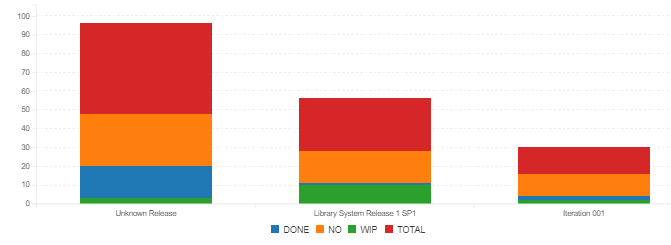Why do we need this analysis?
The important thing about task is that they represent activities signifying the 'Definition of Done'. These activities can be part of a known release that contains iterations/sprints or the committed iterations. Frequently task analysis is limited to a release or iteration.
However, it is also possible that backlog refinement activities is required to be done so that the requirements or the user stories are detailed appropriately for the team to engage in affinity estimation (right sizing using T-shirt or Coffee cup approaches). Only then, the epics are disaggregated into features and the features are broken further into multiple user stories or large user stories split into smaller stories to facilitate adequate prioritization in sprint/iteration planning. This level of analysis focuses on the 'Definition of Ready' and is equally important. When tasks are not identified outside of any release or iteration or identified tasks not completed, then, this also impacts the productivity of the team or questions the value of the work delivered in releases and iterations.
SQL Query
This query is slightly involved. Please review the Query Explanation for details.
select
case when TT.RELEASE_ID = 0 then "Unknown Release" else R.NAME end as NAME,
SUM(TT.COMPLETED) as DONE,
SUM(TT.NOT_STARTED) as NO,
SUM(TT.IN_PROGRESS) as WIP,
SUM(TT.TOTAL) as TOTAL
from
(
(select
Case when TK.RELEASE_ID is null then 0 else TK.RELEASE_ID end as RELEASE_ID,
TK.TASK_STATUS_NAME,
COUNT(TK.TASK_ID) as Not_Started, 0 as In_Progress, 0 as Completed, 0 as Total
from
SpiraTestEntities.R_Tasks as TK
where
TK.PROJECT_ID = ${ProjectId} and
TK.TASK_STATUS_NAME = 'Not Started' and
TK.IS_DELETED = False
group by
TK.RELEASE_ID, TK.TASK_STATUS_NAME)
union
(select
Case when TK.RELEASE_ID is null then 0 else TK.RELEASE_ID end as RELEASE_ID,
TK.TASK_STATUS_NAME,
0 as Not_Started, COUNT(TK.TASK_ID) as In_Progress, 0 as Completed, 0 as Total
from
SpiraTestEntities.R_Tasks as TK
where
TK.PROJECT_ID = ${ProjectId} and
TK.TASK_STATUS_NAME = 'In Progress' and
TK.IS_DELETED = False
group by
TK.RELEASE_ID, TK.TASK_STATUS_NAME)
union
(select
Case when TK.RELEASE_ID is null then 0 else TK.RELEASE_ID end as RELEASE_ID,
TK.TASK_STATUS_NAME,
0 as Not_Started, 0 as In_Progress, COUNT(TK.TASK_ID) as Completed, 0 as Total
from
SpiraTestEntities.R_Tasks as TK
where
TK.PROJECT_ID = ${ProjectId} and
TK.TASK_STATUS_NAME = 'Completed' and
TK.IS_DELETED = False
group by
TK.RELEASE_ID, TK.TASK_STATUS_NAME)
union
(select
Case when TK.RELEASE_ID is null then 0 else TK.RELEASE_ID end as RELEASE_ID,
"Total" as TASK_STATUS_NAME,
0 as Not_Started, 0 as In_Progress, 0 as Completed, COUNT(TK.TASK_ID) as Total
from
SpiraTestEntities.R_Tasks as TK
where
TK.PROJECT_ID = ${ProjectId} and
TK.IS_DELETED = False
group by
TK.RELEASE_ID, TK.TASK_STATUS_NAME)) as TT
left join SpiraTestEntities.R_Releases as R on
R.PROJECT_ID = ${ProjectId} and TT.RELEASE_ID = R.RELEASE_ID
group by
TT.RELEASE_ID, R.NAME
having
sum(TT.TOTAL) > 10
order by
TOTAL desc
Query Explanation
- This query is made of multiple similar subqueries joined by the union statement with an outer query for summing the results and filtering the results using the having clause.
- Each inner subquery checks in the SELECT clause if tasks are assigned to a release and brings 0 when tasks are not assigned to any release so that this information can be manipulated in the outer query.
- While each inner subquery counts the number of tasks in the SELECT clause, the WHERE clauses applies
- filtering for specific status (TASK_STATUS_NAME = 'Not Started') except for the last inner subquery to get the total without a status.
- picking tasks that are not deleted (IS_DELETED = False)
- applying the current project selection (PROJECT_ID = ${ProjectId})
- Groups the result as identified in the select clause
- The outer query translates RELEASE_ID = 0 to a text "Unknown Release" and sums the completed task count as DONE, Not Started task counts as NO, In Progress task counts as WIP and the total counts TOTAL.
- The outer query also applies
- Groups results according to the SELECT clause fields
- Applies the Having SQL clause to apply pareto thoughts on where the maximum focus should apply (e.g.: Where TASK COUNTS > 10 so that one can dig deeper in to the behavioral patterns contributing to executing the required product/project activities.
- The results are ordered by total in the descending order for analysis.
Results Output
Given below is the results of this query.

Creating a Custom Report
If you wanted this data to be present in a report form, follow the steps below.
- Use the "Edit Reports" section under the System Administration (You should have the appropriate permissions)
- Create a New Report
- Fill the details like name, description, category, format, etc.
- Click on the "Add new Custom Section" under the Custom Section
- Give a name to the custom section at a minimum
- Fill the query section with SQL Query from the above section
- Preview the Results
- Click on "Create Default Template"
- Modify the XSLT template if desired for additional customization (Optional)
- Save the custom section and the Custom Report (Yes, two Save buttons must be clicked)
Graph Output
When this data is represented, it can be represented either as bar graph or line graph as shown below.
| Bar Graph |  |
| Line Graph |  |
Good Practices - Graph Interpretation
- While both the bar graph and the line graph equally represent the information clearly, it is possible that the review team look at the "TOTAL" column alone in the bar chart and be concerned. Since the total represents Not Started, In Progress, and Completed, it only represents the volume of work. So, the management review can focus on whether too much work is taken on in a sprint (prioritization inflation, estimation accuracy, etc.) or why too much backlog refinement is not happening in the unassigned releases.
- If the focus is not the volume of work, then the line graph can be seen where it is possible to quickly remove the TOTAL line (which always will be at the top because it aggregates the information) from consideration and focus on the Not Started and In Progress areas.